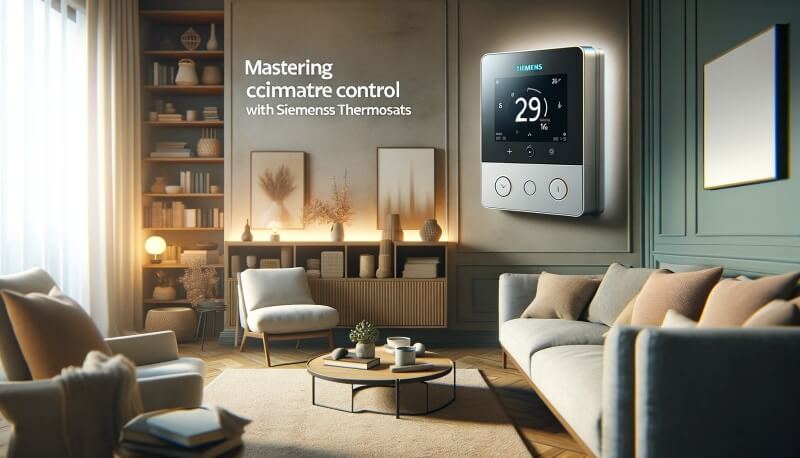Key Takeaways
| Aspect | Detail |
|---|---|
| Key Feature | Easy-to-use interface |
| Application | Suitable for residential and commercial settings |
| Modes | Heat, Cool, Fan, and Off Modes for diverse climate control |
| Customization | Adjustable temperature settings |
| Integration | Compatible with various Siemens systems |
Siemens thermostats are renowned for their user-friendly design and advanced features, making them an ideal choice for both residential and commercial environments. These thermostats offer a blend of functionality and aesthetic appeal, ensuring seamless integration into any space.
Understanding the Basics: Installation and Setup
Before diving into the use of Siemens thermostats, it's crucial to ensure proper installation. This process typically involves following the detailed instructions provided with the thermostat. Once installed, the thermostat is ready for initial configuration. Learn more about the seamless integration with Siemens PLCs, a pivotal component in industrial automation.
Navigating Modes and Settings
A central feature of Siemens thermostats is the "Mode" switch, which allows users to select between "Fan," "Heat," or "Cool" modes, catering to different environmental needs. The "Set Point Adjuster" knob is used to set the appliance to the desired temperature, offering precise control over the room's climate.
Fan, Heat, and Cool Modes
- Fan Mode: Activates the fan for air circulation without heating or cooling.
- Heat Mode: Enables the heating system to maintain a cozy room temperature.
- Cool Mode: Engages the cooling system for a refreshing indoor environment.
Temperature Control and Adjustments
Adjusting the temperature on a Siemens thermostat is straightforward. For models like the RDJ10RF, a simple knob turn changes the room temperature to your preference. This user-friendly approach is consistent across Siemens' range, including advanced models that integrate with building automation systems like Siemens HMIs.
Advanced Features: Programmable Settings and Integration
Siemens thermostats offer more than just basic temperature control. They are equipped with programmable settings, allowing users to schedule heating and cooling cycles according to their daily routines. This functionality is particularly beneficial in commercial settings, where maintaining an optimal climate is crucial.
Additionally, advanced models offer integration capabilities with other Siemens systems, such as Siemens Inverters, enhancing overall efficiency and control. The compatibility with various systems ensures that Siemens thermostats can be a part of a comprehensive climate control solution.
Maximizing Efficiency with Programmable Features
One of the standout aspects of Siemens thermostats is their programmable features. Users can set specific temperatures for different times of the day, ensuring optimal comfort while also saving on energy costs. This is especially advantageous in office buildings or homes where the need for heating or cooling varies throughout the day.
Setting Up Custom Schedules
- Morning Routine: Program the thermostat to warm up the house before waking up.
- Daytime Settings: Reduce heating or cooling when the house is empty.
- Evening Comfort: Increase comfort levels when the family is home.
Remote Access and Smart Integration
Advanced Siemens thermostat models offer remote access capabilities, allowing users to adjust settings via a smartphone app. This feature is invaluable for making last-minute changes to the temperature settings, ensuring a welcoming environment upon arrival at home or the office.
Understanding Special Modes: Off and System Settings
The Siemens thermostat also includes an "Off Mode," where the heating or cooling systems are completely shut down, and a "System Settings" mode for more detailed customization. In the "System Settings," users can fine-tune various aspects of the thermostat's operation to suit their specific needs. This level of control is particularly useful in complex environments, such as those managed by Siemens S7-1500 PLCs, known for their advanced automation capabilities.
Navigating the Menu: Adjusting System Preferences
Adjusting system preferences on a Siemens thermostat involves using the "Menu" button to navigate through various options. Users can easily select and adjust settings like "Set Temperature," ensuring that the thermostat responds accurately to their preferences.
Complementing the Siemens Ecosystem
Siemens thermostats are designed to work seamlessly within the broader Siemens ecosystem. For instance, integration with Siemens S7-1200 PLCs can enhance the automation of heating and cooling systems, providing a more efficient, responsive environment. This compatibility extends to various other Siemens products, like the LOGO! 2 logic module, further highlighting the versatility and adaptability of Siemens thermostats in different settings.
Leveraging Energy Efficiency and Cost Savings
The intelligent design of Siemens thermostats not only enhances user comfort but also contributes significantly to energy efficiency. By allowing precise temperature control and programmable settings, these thermostats ensure that energy usage is optimized, leading to cost savings and a reduced environmental footprint.
Eco-Friendly Operation
- Reduced Energy Consumption: Programmable settings prevent unnecessary heating or cooling.
- Optimized Performance: Integration with Siemens systems ensures efficient operation.
Troubleshooting and Maintenance Tips
To maintain the optimal performance of a Siemens thermostat, regular troubleshooting and maintenance are essential. Users should periodically check the thermostat for any issues and refer to the user manual for guidance on resolving common problems. Routine checks ensure the longevity and reliability of the thermostat, minimizing the need for professional servicing.
Common Troubleshooting Steps
- Battery Replacement: Ensure the thermostat’s batteries are fresh for consistent performance.
- System Reset: Sometimes, a simple reset can resolve minor issues with the thermostat.
Enhancing User Experience with Siemens Support
Siemens offers robust support for their thermostats, including detailed manuals, online resources, and customer service. This support ensures that users can maximize the potential of their thermostats and get assistance when needed.
Accessing Siemens Resources
- Online Manuals: Comprehensive guides for installation and operation.
- Customer Service: Expert assistance for troubleshooting and queries.
Conclusion
In conclusion, Siemens thermostats represent a perfect blend of functionality, efficiency, and user-friendliness. Their programmable features, energy-saving capabilities, and seamless integration with Siemens systems like Siemens inverters make them an ideal choice for a wide range of applications. With the added advantage of robust Siemens support, these thermostats stand out as a top choice for effective climate control solutions.



